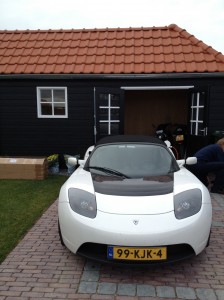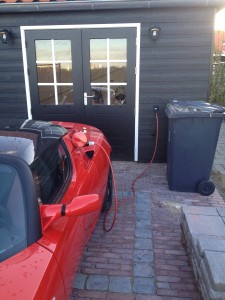While the shed in my backyard is still under constructing I started installing the Type 2 socket on the outer wall on the side of my parking spot.
For my EVSE I’m using the Open EVSE project. Although we use a different connector in Europe, the signaling is the same as with the J1772 connector. One other advantage is that the European connector has support for 3-phase power.
My shed has a outer and inner wall with the main supports in between them, I’m trying to run most cabling inside the wall for the aesthetics. For the socket it was also the easiest way.
A couple of pictures of what I did so far (still took me 5 hours though! Those stiff cables don’t make it any easier!).
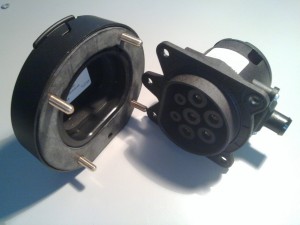
This is the Type 2 socket for installation in a wall. This picture is without the interlocking actuator. The actuator is used for locking the connector in the socket while charging. It’s to prevent you from taking out a connector which might be carrying 22kW of power, that would give some fireworks!
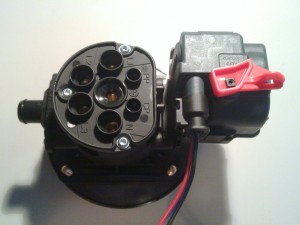
This is the socket with the actuator installed on top of it. It’s a very simple 12V motor which pushes a pin into the socket and locking the connector in place.
I haven’t found a way yet to control this with the Open EVSE project, but I’m positive I’ll find a way to do so.
Locking is done by putting 12V on it for 300ms and unlocking is done by simply reversing the poles. Any suggestions how to do this with Open EVSE are welcome!
This now had to be installed in the outer wall of my shed. This wall is 11mm thick while the connector is build for 9mm at max. It took some power tools to get about 4mm off that wall!
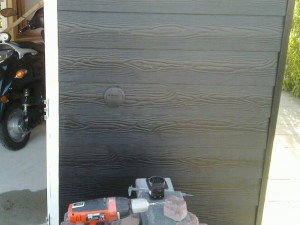
This is how it looks on the outer wall after installation. You can see the actual socket still lying there, but the outer cap has been installed.
The socket itself is very well build by Mennekes. Rubbers everywhere to prevent water from coming in, but it also has water drainage output on the bottom. Should somebody plug in a connector full of water the excess water can flow out of the socket.
It’s a pretty expensive socket (EUR 300,00) but they did their job of creating a descent one!
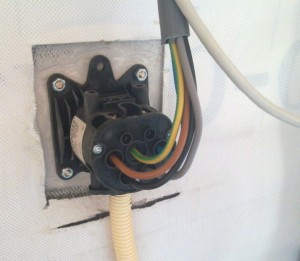
This picture shows the installed socket from the back with the main power lines connected.
WARNING: These cables are NOT energized! The power flow is controlled by the EVSE with a relais. Take note of that should you consider installing your own EVSE!
The PP (Proximity Pilot) and CP (Control Pilot) pins are not connected yet, you however see the CAT6 cable already there. I’m using that cable for the CP and PP pins as well as for controlling the actuator.
The power cable is a 5G6 cable. This means 5 wires of 6mm2 each. My goal is to have this EVSE installation be able to deliver 3-phase 32A (22kW). 4mm2 cabling would maybe have done the job, but safety first! It also means less voltage drop, so more kW to the car!
The flexible PVC hose at the bottom is water drainage from the socket, should water enter the socket it can flow out of the socket through there.

This is how it all looks after installation with the actuator installed.
One PVC pipe carries the the main power cable while the other carries the CAT6 cable for controlling the actuator and connecting the PP and CP pin.
The pipes run through the structure towards the main power panel (yet to be installed) where I’ll also install the Open EVSE.
Between the outer and inner wall there will be insulation, but I have to prevent this from making contact with the socket. I still have build something for that around the socket, I want to make sure the insulation doesn’t catch fire for some reason. (Although I don’t know if it actually burns).
It’s better to be safe then sorry in this case. 22kW of power will flow through here, that is something not to be taken lightly, that is some serious amount of power!
If you want to order this socket yourself contact EV-Box (Netherlands), they can help you with that.
These are the parts I ordered (Mennekes part numbers):
- 30012: Fixing ring with hinged lid IP44
- 31016: Type 2 socket 32A with actuator
- 30019: Actuator connector with 3 wires of 1m each
When I finish my EVSE I’ll post a full list of components I used.
Now it’s back to my shed for doing some more installation of other electronics like lighting.

